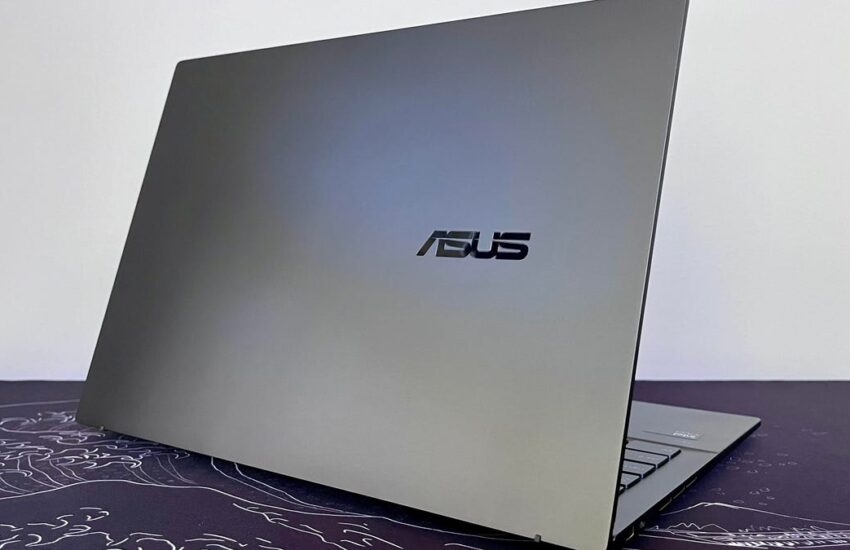
Pros
- Good OLED display for the price
- Lightweight for a 14-inch laptop
- Long battery life
Cons
- Aluminum frame a bit flimsy
- Display hinge isn’t great
- Mediocre touchpad
Spend $1,000 on a laptop and you’ll generally end up with a mainstream model with peppy application performance inside an aluminum chassis with a decent IPS display. In some instances, you can find a higher-resolution IPS panel like we saw recently with the 2.2K IPS display on the Dell Inspiron 14 Plus or an OLED panel as supplied by the Lenovo Slim 7i. The Asus Zenbook 14 OLED Q425 follows a recipe similar to that of the Slim 7i with its 14-inch OLED touch display powered by an Intel Core Ultra 7 processor. Just by virtue of the superior fidelity of its OLED display, the Zenbook 14 OLED Q425 stands out from the midrange laptop crowd but also feels like a lesser version of the Slim 7i.
The Zenbook 14 OLED Q425 is lighter and longer running than the Slim 7i, but this increased portability comes at the expense of build quality. The Zenbook 14 OLED Q425’s aluminum enclosure suffers from a not insignificant amount of flex and doesn’t feel nearly as sturdy as the Slim 7i’s rigid case. The Zenbook 14 OLED Q425’s audio output also pales in comparison to the sound of the Slim 7i’s quad speakers. Despite these demerits, the Zenbook 14 OLED Q425 still remains a strong contender among mainstream laptops at its price of $1,050. It’s just that the Lenovo Slim 7i offers an even better package and usually for less.
Asus Zenbook 14 OLED Q425
| Price as reviewed | $1,050 |
|---|---|
| Display size/resolution | 14-inch 1920×1200 OLED |
| CPU | Intel Core Ultra 7 155H |
| Memory | 16GB LPDDR5X 7467MHz RAM (soldered) |
| Graphics | Intel Arc |
| Storage | 1TB SSD |
| Ports | 2x Thunderbolt 4 USB-C, USB 3.2 Gen 1 Type-A, HDMI 2.1, combo audio |
| Networking | Wi-Fi 6E and Bluetooth 5.3 |
| Operating system | Windows 11 Home 23H2 |
| Weight | 2.9 pounds (1.3 kg) |
The Q425 model of the Asus Zenbook 14 OLED is a fixed configuration available at Best Buy for $1,050. It features an Intel Core Ultra 7 155H processor, 16GB of RAM, integrated Intel Arc graphics and a 1TB SSD. The 14-inch OLED display features a 1,920×1,200-pixel, a standard 60Hz refresh rate and touch support. A less expensive Q415 model sells for $800 at Best Buy. It offers the same OLED display but with a Core Ultra 5 135H CPU, 8GB of RAM and a 512GB SSD.
The higher-end Q425 model drops to as low as $800 when it’s on sale at Best Buy, but it’s usually found at its full price of $1,050.
The Asus ZenBook 14 OLED Q415 and Q425 are unavailable in the UK or Australia, but the similar ZenBook 14 OLED UX3405 can be found. It’s based on the same Core Ultra 7 155H chip but offers a 14-inch OLED with a higher-res 2.8K resolution. The ZenBook 14 OLED UX3405 starts at £1,100 in the UK and AU$1,899 in Australia.
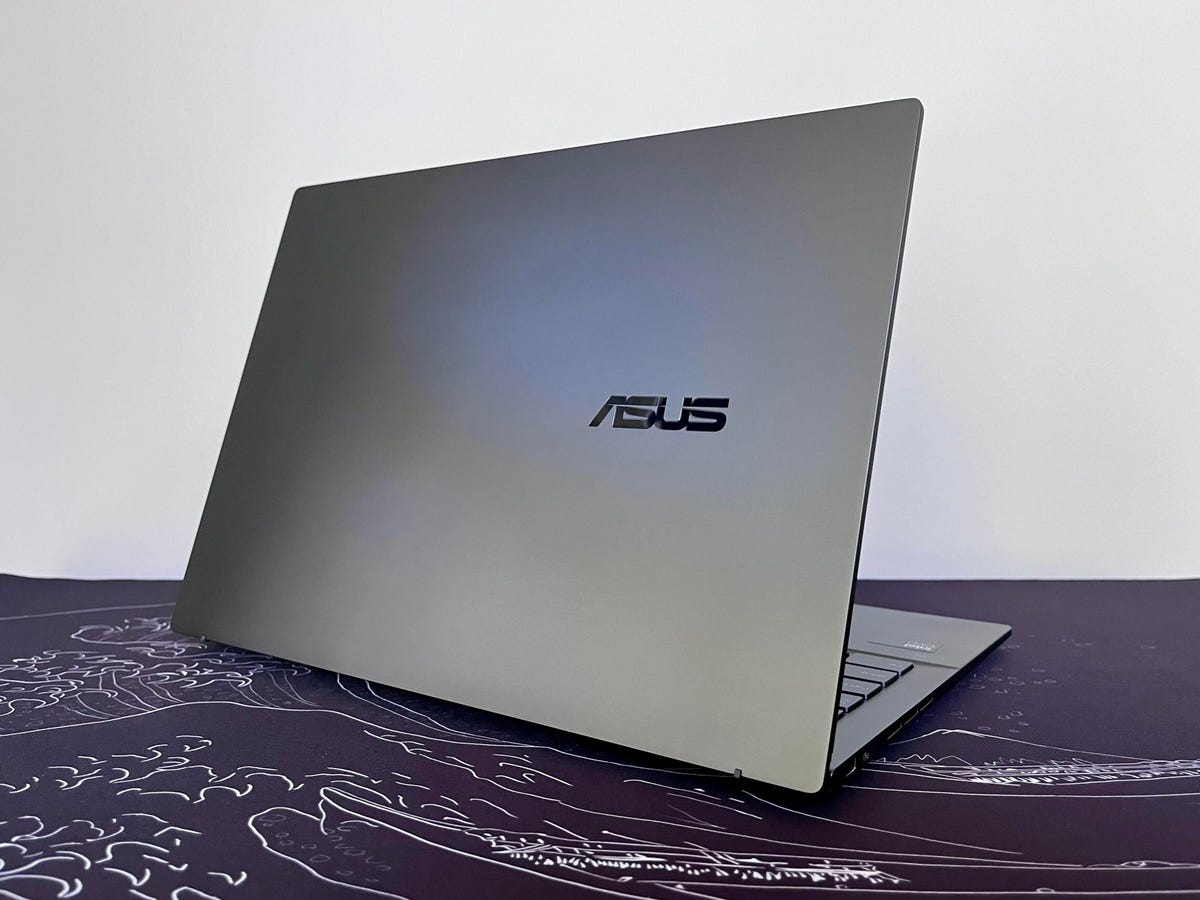
In testing, the Zenbook 14 OLED Q425 proved to be a capable mainstream performer. It was faster than the Dell Inspiron 14 Plus and Lenovo Slim 7i on our application benchmarks but lagged behind each on our graphics tests. In general, it felt speedy during general Windows use and handled various multitasking scenarios without any hiccups or lags while staying cool and quiet during operation.
It also produced an excellent result in battery testing, lasting more than 13 hours on our online video streaming battery drain test. That’s an impressive runtime for any laptop, especially for an OLED model. Granted, the lower-resolution and slower 60Hz refresh help it run longer than higher-end OLED laptops with higher-resolution, 120Hz panels that require more power, but the Zenbook 14 OLED Q425 is still a rarity among laptops by providing both an OLED display and long battery life.
Understated and lightweight but a bit flimsy
The Zenbook 14 OLED Q425’s all-metal chassis is charcoal gray with a charcoal gray keyboard to match. There is minimal branding, and the geometric lines that adorn the lid of many Asus laptops are absent. The display features edge-to-edge glass that adds an air of luxury to the laptop’s overall look. The seamless display covering looks way more modern and premium than the clunky, plastic bezels found on many laptops at this price.
The Zenbook 14 OLED Q425 is one of the most portable 14-inch laptops I’ve tested and nearly as lightweight as the slightly smaller 13.6-inch MacBook Air. At just 2.9 pounds, the Zenbook 14 is just a hair heavier than the 2.7-pound MacBook Air. And measuring 12.3 inches wide by 8.7 inches deep by 0.6-inch thick, it has the same dimensions as the Lenovo Slim 7i but is lighter. It’s also one of few 14-inch laptops that weighs less than 3 pounds. The Slim 7i and HP Spectre x360 14 each weigh 3.2 pounds, and the Dell Inspiron 14 Plus weighs 3.5 pounds. The 14-inch model closest in weight to the Zenbook 14 is the 3-pound Acer Swift Go 14.
Lighter isn’t always better, though. I’d argue it’s better to tote around a few extra ounces with the Slim 7i’s superior build quality. Its case is much more rigid than the Zenbook 14’s, whose thin aluminum surfaces flex too much to my liking. The top cover behind the display doesn’t bend like the lids on many thin laptops, but it still feels flimsier than the Slim 7i because of the flex that can be felt.
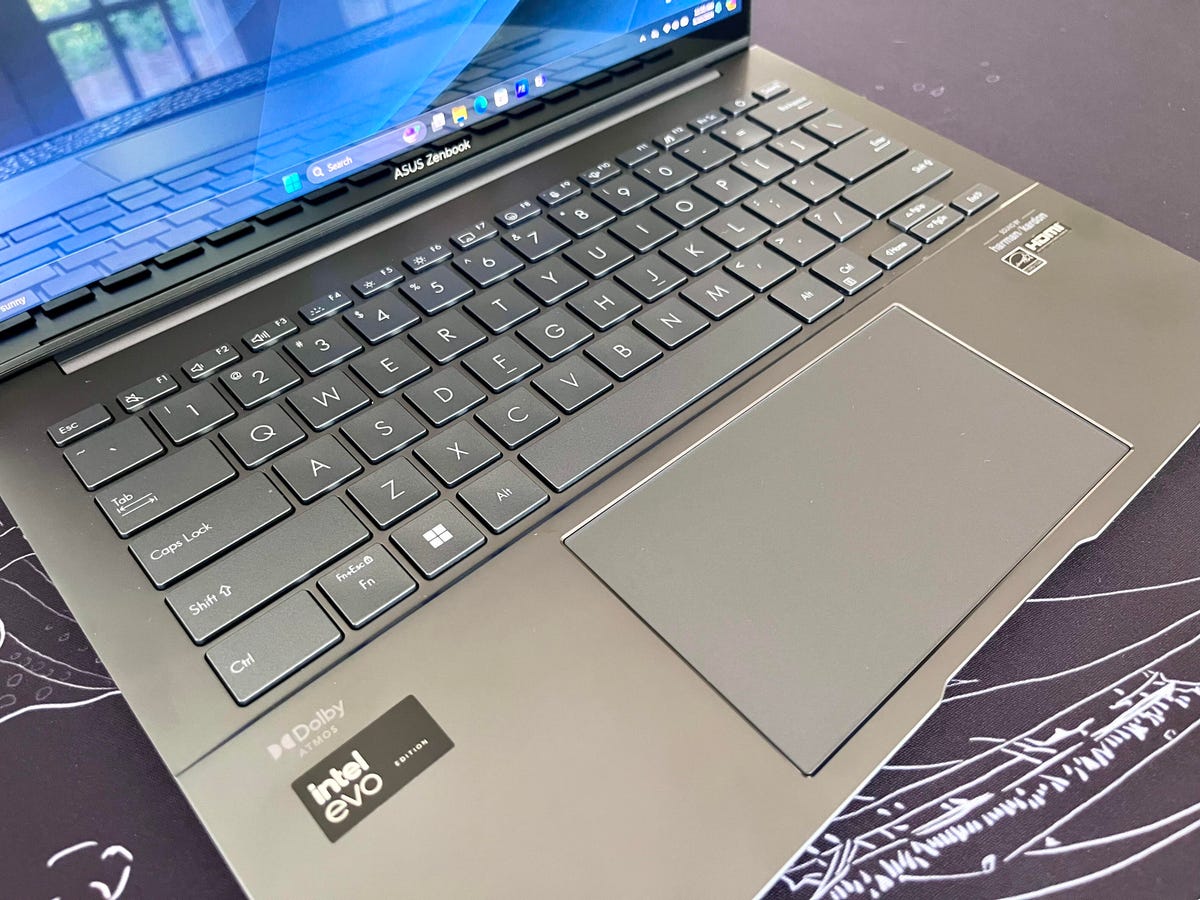
When you pick up the laptop, you can feel both the top and bottom covers flex between your thumb and fingers, which doesn’t inspire confidence in its durability. However, Asus claims the Zenbook 14 OLED Q425 passes MIL-STD 810H ruggedness standards for protection against various abuses such as drops, vibration, shock, dust and extreme temperatures. The Slim 7i offers the same military-grade ruggedness and remains my choice between this pair of mainstream 14-inch OLED laptops.
Thankfully, the Zenbook 14 OLED Q425’s keyboard deck is firmer than its top or bottom panels, with less flex under the keys and an enjoyable typing experience. The key travel is shallow, but there’s enough bounce that my typing felt fast and accurate. The mechanical touchpad, however, is merely average. It accurately recorded my swipes, pinches and other mousing gestures, but its click response has a bit too much travel, especially along its bottom edge. It suffers from the “diving board” effect, where clicks feel too firm near its top edge and too soft toward its bottom edge.
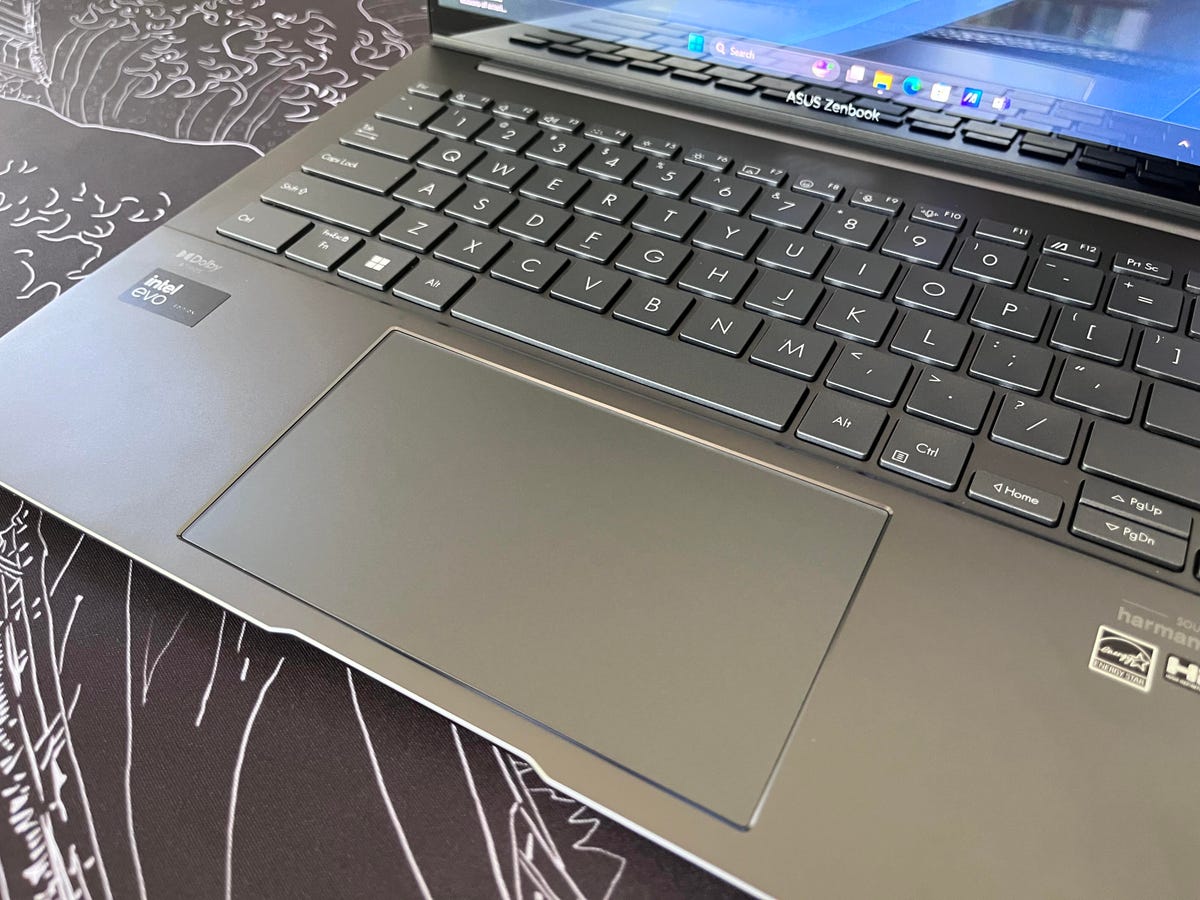
Somehow, the Zenbook 14’s hinge felt both too firm and too weak. I could lift the lid with one finger, but once the display reached about 45 degrees — about halfway to fully open — it was too stiff to continue without lifting the front end, eventually slamming back down on my desk when I let go once hitting roughly 90 degrees. And once I had the laptop opened, the hinge wasn’t strong enough to prevent screen wobble. There’s always some wobble with a laptop’s display, but I’d classify the Zenbook 14 as having an above-average amount.
The display itself is excellent, though; an appreciated inclusion at the Zenbook 14 OLED’s price. It’s basically the same specs as the OLED panel we saw on the Slim 7i — a 14-inch, 16:10 display with a 1,920×1,200-pixel resolution, 60Hz refresh rate and touch support. That’s a lower resolution and slower refresh rate than you’ll find on pricier OLED models, but those are the tradeoffs you must make to get an OLED display and remain in the ballpark of $1,000. Text isn’t as sharp as you get with the 2.2K display on the Dell Inspiron 14 Plus, but the OLED display provides better contrast, deeper black levels and more vivid colors than you get with an IPS LCD display.
In testing with a SpyderX Elite colorimeter, the display covered 100% of the sRGB and P3 color spaces and 95% of Adobe RGB. I measured a peak brightness of 340 nits, which falls short of the display’s 400-nit rating. It’s also less than the 382 nits that the Slim 7i reached in testing.
With its excellent contrast, however, an OLED doesn’t need to be as bright to stay visible in direct light as an IPS. I was able to use the Zenbook 14 outdoors on a bright but hazy day, as well as many mornings in my sunny breakfast nook.
The Zenbook 14’s display may be nearly identical to the Slim 7i’s, but its speakers are not. The sound produced by the Zenbook 14’s stereo speakers isn’t nearly as full as the audio output I experienced with the Slim 7i’s quad-speaker array. They may be Harman Kardon-tuned speakers, but they deliver typical tinny laptop sound. The Zenbook can hit an impressive volume, but quality begins to degrade quickly as you push the volume past 50%.
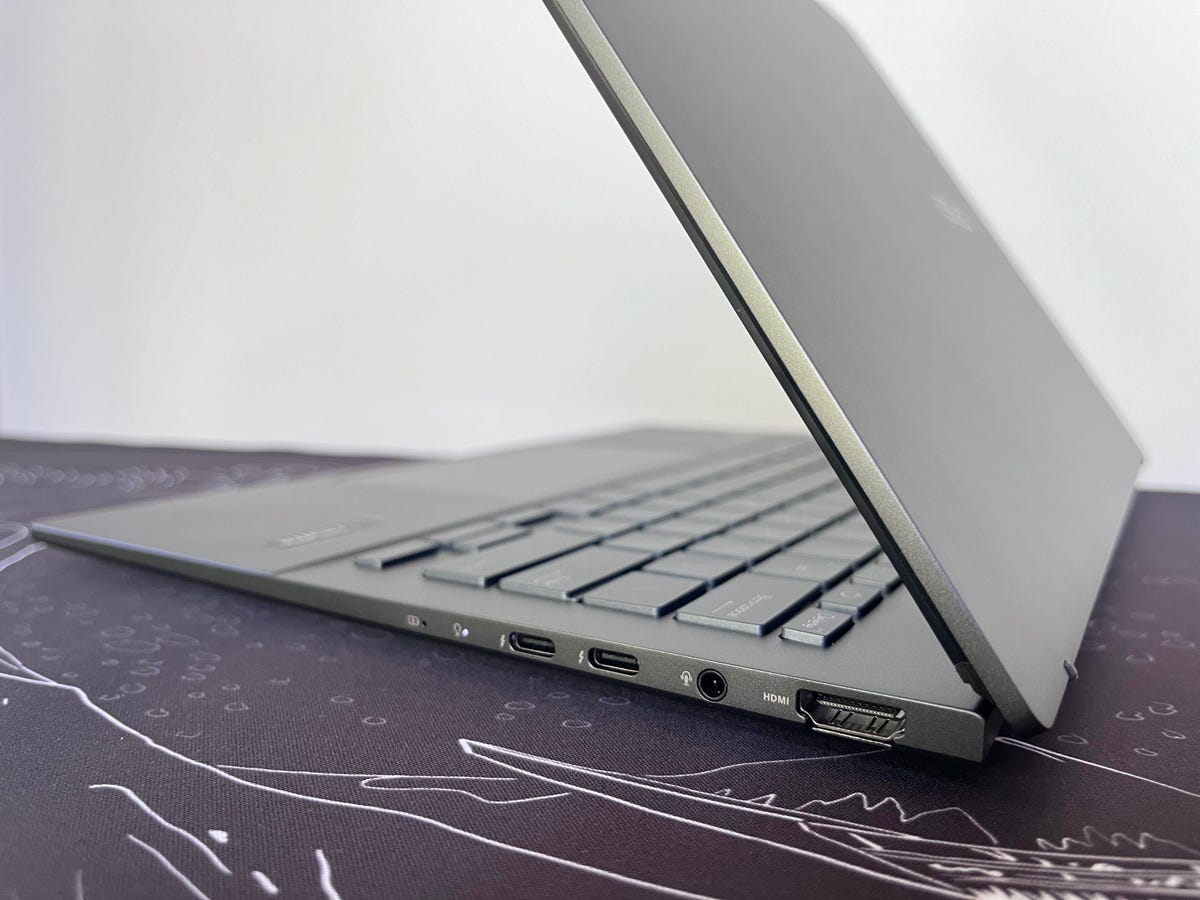
The 1080p webcam produces crisp, well-balanced images and has an IR sensor, so you can use it with Windows Hello for easy, secure logins without needing to key in passwords. The laptop lacks a fingerprint reader, leaving facial recognition from the webcam as the only biometric option for logins. The webcam also features a physical shutter, so you can protect your privacy when the camera isn’t in use. It’s a feature I always like to see on a laptop.
The Zenbook 14’s port selection mirrors that of the Slim 7i, offering a useful mix of Thunderbolt 4 USB-C and USB-A connectivity and an HDMI out and headphone jack. The only absence some buyers might miss is an SD card slot. Those buyers would likely be creative hobbyists eyeing the Zenbook 14 as an inexpensive OLED laptop for light media editing and content creation. I say “light” because graphics pros looking for a content-creation laptop will want more of a graphics punch than what’s afforded by the integrated Intel Arc GPU.
Overall, the Asus Zenbook 14 OLED Q425 offers strong value for its price. You get capable overall performance from the Core Ultra 7 processor and Intel Arc graphics, along with great battery life. And getting an OLED display at this price is a boon. It’s just that the Lenovo Slim 7i offers a nearly identical OLED display powered by a similar configuration with twice the RAM inside a higher-quality enclosure. The Slim 7i is a better deal at $1,000 at Costco than the Zenbook 14 OLED Q425 is at Best Buy for $1,050. Then again, the Zenbook 14 OLED Q425 can occasionally be found on sale at Best Buy for $800, where it becomes a more attractive proposition and perhaps the better buy if you value longer battery life more than build quality.
The review process for laptops, desktops, tablets and other computerlike devices consists of two parts: performance testing under controlled conditions in the CNET Labs and extensive hands-on use by our expert reviewers. This includes evaluating a device’s aesthetics, ergonomics and features. A final review verdict is a combination of both objective and subjective judgments.
The list of benchmarking software we use changes over time as the devices we test evolve. The most important core tests we’re currently running on every compatible computer include Primate Labs Geekbench 6, Cinebench R23, PCMark 10 and 3DMark Fire Strike Ultra.
A more detailed description of each benchmark and how we use it can be found on our How We Test Computers page.
Geekbench 6 (multicore)
HP Spectre x360 14 12,897Asus Zenbook 14 OLED Q425 12,818Acer Swift Go 14 12,459Lenovo Slim 7i 12,128Dell Inspiron 14 Plus 7440 11,996
PCMark 10 Pro Edition
Acer Swift Go 14 7,020HP Spectre x360 14 6,893Asus Zenbook 14 OLED Q425 6,785Lenovo Slim 7i 6,764Dell Inspiron 14 Plus 7440 6,551
Cinebench R23 (multicore)
Dell Inspiron 14 Plus 7440 13,243Acer Swift Go 14 12,989Lenovo Slim 7i 11,401Asus Zenbook 14 OLED Q425 8,902HP Spectre x360 14 8,656
3DMark Time Spy
Lenovo Slim 7i 3,875Acer Swift Go 14 3,871Dell Inspiron 14 Plus 7440 3,842HP Spectre x360 14 3,358Asus Zenbook 14 OLED Q425 3,281
Online streaming battery drain test
Dell Inspiron 14 Plus 7440 811Asus Zenbook 14 OLED Q425 791Acer Swift Go 14 760HP Spectre x360 14 595Lenovo Slim 7i 580

